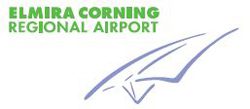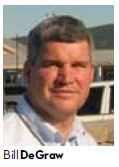
Faced with the prospect of having to clear snow for more aircraft, but do so with fewer staff members, Elmira Corning Regional Airport (ELM) in Horseheads, NY, recently purchased a $757,000 vehicle that allows a single operator to simultaneously plow and sweep.

|
factsfigures Location: Elmira Corning Regional Airport (NY) Project: Multipurpose Snow Removal Vehicle Cost: $757,000 Deployed: October 2010 Dealer: Tracey Road Equipment Tractor: Oshkosh HT-Series 2926 Plow Length: 24 ft. Tow Broom: M-B 4622-CRDL-HP3 Broom Length: 22 ft. Air Blower Capacity: 23,000 cfm & 400 mph Benefits: Allows one operator to simultaneously plow & broom; faster clearing; less snow pack buildup; reduced deicing & lower maintenance costs |
“The new vehicle requires one operator and one truck instead of two trucks and two operators to perform the same task. This is critical, since we have limited staff,” explains Bill DeGraw, director of operations at ELM.
 Now’s the Time
Now’s the Time
The concept of multi-mode snow removal equipment was born about 15 years ago, but was limited to larger airports for the following decade, according to Gary Kogut, regional sales manager, airport and municipal products, East Coast U.S./U.S. Virgin Islands / Eastern Canada, Oshkosh Corporation. Between 2004 and 2006, Kogut began to see the idea trickle down to smaller airports. “Approximately eight of our HT-Series (multi-function) units have gone to customers in the small hub airport category,” he reports.
“Multipurpose equipment didn’t take off initially because airports had a lot of people,” reasons Art Ospelt, the salesman and general manager of Tracey Road Equipment’s Binghamton, NY, office. Ospelt, who handled the sale to ELM, says that as airports have trimmed operations departments staffing, they are more open to purchasing multipurpose equipment.
“All of the airports I cover are down in the number of their employees,” he says, noting that they still have to get snow off the runways. “You can’t keep planes in the air.”
Making the Case
As smaller airports began to suffer staff cuts, the business case for more expensive multi-purpose vehicles became more compelling. The $757,000 Oshkosh/M-B vehicle ELM purchased may cause sticker shock compared to a $200,000 plow truck with spreader and a $400,000 front mount broom and chassis. There is, however, much more than the up-front cost to consider, DeGraw explains: “You only need one operator, which saves personnel costs. A multi-tasking vehicle has one chassis and two engines that need lube, oil, filters, etc. A plow truck and a front mount broom have two chassis and three engines to maintain.”

There is also the “Little Bo Peep” factor: Wherever the plow goes, the broom follows. “We are doing more brooming to remove snow better,” DeGraw reports. “Since there has been less packed snow and ice, we are using less de-ice materials and sand.”
By January, the airport would have usually applied 6,600 to 8,800 pounds of sodium acetate solid de-ice from Cryotech De-Icing Technology and three to four applications of potassium acetate liquid de-ice from Clariant Corporation. By early January of this winter, however, the airport had only used 2,200 pounds of solid de-ice and one application of liquid de-ice.
With two runways (one 7,599 feet long, the other 5,404 feet), ELM crews have a total of 48 lane miles of runways and taxiways and 36 acres of apron space to clear. Traffic figures were up 15% in 2010 over 2009, and the airport logged more than130,600 enplanements and nearly 32,000 aircraft operations.
Piedmont Airlines uses two deicing trucks to deice US Airways and Delta aircraft at a designated deicing apron. Fixed-base operator (FBO) Atlantic Aviation operates a third deicing truck. Carriers are responsible for their own deicing or can contact the FBO for deicing services. Glycol run-off is collected into an underground storage tank and slowly metered and pumped into the sanitary sewer.
With an average of 38 snow events per season, ELM operates five plow trucks: a 1978 Oshkosh P-Series, 1988 FWD, 1999 Volvo, 2004 Sterling and 2010 Mack. Each is equipped with a 20-foot Frink plow and slide-in material spreader. Two Oshkosh H-Series chassis, a 2001 and a 2005, are equipped with Sweepster 18-foot runway brooms with air blast. There are two runway snow blowers: a 2000 Oshkosh H-Series and a 1988 Idaho Norland. Liquid deicing is performed with a Tyler Ice 50-foot boom sprayer towed by a John Deere tractor. A 1995 Case 821 loader has plow, ramp hog and snow basket attachments. The multipurpose Oshkosh HT-Series/M-B vehicle is the newest addition to the fleet.
DeGraw has observed a “noticeable difference” in how quickly the runways and taxiways are getting cleared since the airport added the new equipment. “With the third broom and the ability to cover more surface in a single pass, it is taking less time to get improved (aircraft) braking over a larger surface,” he reports. “The additional brooming on the aprons and taxiways has also improved conditions, compared to previous years.”
The new vehicle can be intimidating at first: The tractor has a 158-inch wheelbase and the M-B tow broom is 70 feet long from nose to tail. But crews adjusted to the mammoth machine. “After doing some training and hands-on operation of the truck, it is not as difficult to operate as it appears,” relates DeGraw. “The truck is extremely maneuverable. We have turned it around in 50-foot taxiways without any problems. A single joystick controls the plow and broom together. The broom can be turned in line with the chassis and suspended from cradles for storage so that the truck is narrower to back into the maintenance building for storage and service.”
The unobstructed view from the cab is another advantage. “Compared to a front-mount broom, having the broom behind you provides for much better visibility,” remarks DeGraw.


